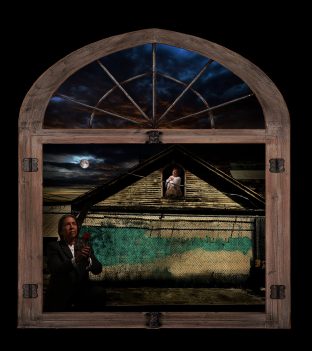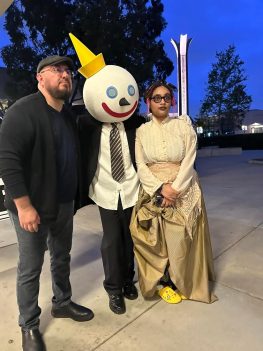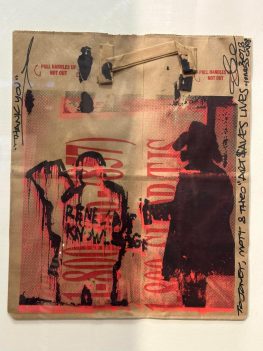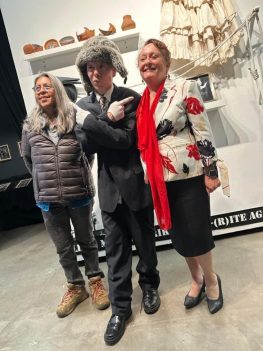 Los Angeles, CA (The Hollywood Times) 3/9/23 – With much admiration for your years of commitment to the treasured institution of Education in serving as a Curator, Professor, and Educator at Cypress College and the Director of the Cypress Art Gallery. With confirmation, I will be meeting with you and the Photographer Chair today March 9th, 2023, at 1 pm. I am honored to personally share and present my most recent exhibit with its institutional critique of hegemony which seeks to invite you and your community to an exclusive discourse, our dialogue will build legitimacy as our alliance via a proposed critique that will question our culture in question.
Los Angeles, CA (The Hollywood Times) 3/9/23 – With much admiration for your years of commitment to the treasured institution of Education in serving as a Curator, Professor, and Educator at Cypress College and the Director of the Cypress Art Gallery. With confirmation, I will be meeting with you and the Photographer Chair today March 9th, 2023, at 1 pm. I am honored to personally share and present my most recent exhibit with its institutional critique of hegemony which seeks to invite you and your community to an exclusive discourse, our dialogue will build legitimacy as our alliance via a proposed critique that will question our culture in question.
 In sharing my most recent project for my Artist in Residency at Cypress College beginning as its point of departure through the calling of studying racial epithets through staged contrived photographs which will reference MEXICO’s rich historical Caste Paintings. I will present modern Contemporary allegorical narratives como novellas through contrived and embellished photographic staged portraits of select activist subjects from our community that will be placed in our public sphere through Los Angeles media outlets and publications. My proposed expressed language of imago’s seeks to revive obscure historical movement drawn from archival and historical sources through recasting its bastardized form and its comprehensive study of colonial caste painting.
In sharing my most recent project for my Artist in Residency at Cypress College beginning as its point of departure through the calling of studying racial epithets through staged contrived photographs which will reference MEXICO’s rich historical Caste Paintings. I will present modern Contemporary allegorical narratives como novellas through contrived and embellished photographic staged portraits of select activist subjects from our community that will be placed in our public sphere through Los Angeles media outlets and publications. My proposed expressed language of imago’s seeks to revive obscure historical movement drawn from archival and historical sources through recasting its bastardized form and its comprehensive study of colonial caste painting.
 I will stage contemporary depictions and portrayals in the Amerika’s exploring how caste painting was re-authored through its critical review of art history, more important my research will critically inspire shared allegorical lesson through mirroring its tableaux vivant staged sets which will critically examine and understand why today’s race, color, gender, and creed has returned to become the subject of its historical pictorial genre. I seek to appropriate its intrinsic value as its artifice to our late capitalistic postmodern via its cynical fin de siècle and exclusively exhibit its first pictorials (Elena Popp EDN Portrait) at Cypress College date TBA. I would love to share this opportunity with you as our journey.
I will stage contemporary depictions and portrayals in the Amerika’s exploring how caste painting was re-authored through its critical review of art history, more important my research will critically inspire shared allegorical lesson through mirroring its tableaux vivant staged sets which will critically examine and understand why today’s race, color, gender, and creed has returned to become the subject of its historical pictorial genre. I seek to appropriate its intrinsic value as its artifice to our late capitalistic postmodern via its cynical fin de siècle and exclusively exhibit its first pictorials (Elena Popp EDN Portrait) at Cypress College date TBA. I would love to share this opportunity with you as our journey.
 The historical genre that I will reference is Casta Paintings which were a historical bastardrized sequel of paintings which were first created in the late 1700s. They were painted for the general public of Spain to show through appearances the racial diversity and mixing of the people in the “New World”.
The historical genre that I will reference is Casta Paintings which were a historical bastardrized sequel of paintings which were first created in the late 1700s. They were painted for the general public of Spain to show through appearances the racial diversity and mixing of the people in the “New World”.
Curator Ilona Katzew, an art historian at NYU’s Institute of Fine Arts, notes in the catalogue that Spanish colonists commissioned Casta paintings and sent them abroad, usually as gifts, to display their wealth and to demonstrate that a noble class system prevailed in the New World.
 Casta paintings first appeared during the historical reign of the first Bourbon monarch of Spain, Phillip V (1700-46), and grew in popularity throughout the eighteenth century. Casta Paintings remained in demand until the majority of Spain’s American colonies became independent by 1821.
Casta paintings first appeared during the historical reign of the first Bourbon monarch of Spain, Phillip V (1700-46), and grew in popularity throughout the eighteenth century. Casta Paintings remained in demand until the majority of Spain’s American colonies became independent by 1821.
PURO SANGRE
 The castas system were intentionally created to preserve Colonialist wealth, power, and privilege, where the Spanish created a caste-like system, the “Sistema de Castas,” with Spaniards in the tier top group. Other races were ranked below based on their percentage of Spanish blood.
The castas system were intentionally created to preserve Colonialist wealth, power, and privilege, where the Spanish created a caste-like system, the “Sistema de Castas,” with Spaniards in the tier top group. Other races were ranked below based on their percentage of Spanish blood.
Many castes in Mexican society were impacted by the divisive form and became resentful of the racial, economic, and land inequality that was present due to colonial rule and the rigid caste system imposed by the Spanish. The Creoles resented the fact that they were considered inferior to the Peninsular, just because they were born in the Americas.
 Casta Painting was a genre painting that was common in Mexico in the 18th century which depicted race color and breed, referenced from a racially mixed family, consisting of the two parents (of different races) and their child. Viceroyalty. The territory controlled by a person who rules in place of the king or queen.
Casta Painting was a genre painting that was common in Mexico in the 18th century which depicted race color and breed, referenced from a racially mixed family, consisting of the two parents (of different races) and their child. Viceroyalty. The territory controlled by a person who rules in place of the king or queen.
Casta paintings used labels and visual details such as different skin tones, dress, occupations, and settings to distinguish ethnicity where through significations which signaled economic and class divisions. Like modern campaigns, its images did not reflect reality so much as represented a perceived reality where stereotypes and xenophobic beliefs were intentionally categorized and classified through a biased, hierarchical scale.
 What was once known as New Spain now known today known as Mexico was a viceroyalty of the Spanish empire. The presence of people of many different ethnic backgrounds and their relative social mobility in New Spain prompted Spain’s great anxiety about racial mixing and a desire to maintain its pureblood status quo along with a social hierarchy which would only benefit the privilege of Eurocentric lineage and image.
What was once known as New Spain now known today known as Mexico was a viceroyalty of the Spanish empire. The presence of people of many different ethnic backgrounds and their relative social mobility in New Spain prompted Spain’s great anxiety about racial mixing and a desire to maintain its pureblood status quo along with a social hierarchy which would only benefit the privilege of Eurocentric lineage and image.
It was Francisco Clapera who was one of the first Artist who were commissioned the founding of an art academy in New Spain. Clapera directed Casta paintings which were exclusively produced for campaigns which were than exported to Spain, as part of an effort by hegemonic vice royals to demonstrate only title, wealth, power, and market productivity of its colonies in New Spain.
 You jam your culture down my throat.
You jam your culture down my throat.
Say I’m inferior when upon it I choke.
You fill my mind with a false sense of history.
And then you wonder why I have no identity
 Shedding light on the darkness of greed.
Shedding light on the darkness of greed.
Rage Against the Machine
https://www.youtube.com/watch?v=rxTVzi9Nrj4
Our collective ART SAVES LIVES with our expression as our being, courageously seeks to unmask the truth of our time and invites audience and community members like yourself into challenging existing social, perceptions, intellectual, and aesthetic paradigms.
 In continuing our study of Casta painting with its Classism and Racism became an inherent part of not only the new Spain or the colonial world but our nation through its paradigm of post colonialism, its answer is simple because racism has silently proliferated and existed in not only m Mexico but in the United Snakes of Amerika for centuries and revealed through the segregation of its Sundown Towns, the same geographical cities where wrestling as a sport was popular across the west and the Midwest.
In continuing our study of Casta painting with its Classism and Racism became an inherent part of not only the new Spain or the colonial world but our nation through its paradigm of post colonialism, its answer is simple because racism has silently proliferated and existed in not only m Mexico but in the United Snakes of Amerika for centuries and revealed through the segregation of its Sundown Towns, the same geographical cities where wrestling as a sport was popular across the west and the Midwest.
 What’s a Sundown Town in Amerika?
What’s a Sundown Town in Amerika?
A Sundown Town was defined as any organized jurisdiction also known as redlined district, which for decades kept African Americans or any other minority groups from living in its “all-white” towns and was intentional through its design and purpose. There is a reason for the quotation marks around “all-white” in which towns required that its section was literally all-white in the census so that no African Americans could live within select city lines. Many cities in the wrestling strong Midwest cities are still segregated today which is considered inappropriate, because many towns marketed themselves throughout history as sundown towns with a motive only towards the profit incentive. Racially racist land deeded covenants blanketed the Midwest investigated through its historical reading of its terms by researching and sourcing its deeds.
 Roots of racial disparities and divisiveness can also be witnessed in the documentary film titled Jim Crow of the North which explored the origins of Midwest housing segregation in cities like Minneapolis. The documentary illustrates how African American families and leaders resisted this insidious systemic practice, and how Black people built their communities within and despite the red lines where restrictive covenants were created, but most importantly supported by its language of Euphemism. As shared, I believe racism first began in the foundation of language mirrored and emboldened today in Americas Trumpism social paradigm, when cities like Minneapolis have a history of racial discrimination and dissent you will see historical disparagement which has been directed towards its diverse inhabitants. Minneapolis was also the very same city where George Floyd was murdered and publicly executed through a public lynching which was documented by citizen journalists causing widespread riots across Amerika.
Roots of racial disparities and divisiveness can also be witnessed in the documentary film titled Jim Crow of the North which explored the origins of Midwest housing segregation in cities like Minneapolis. The documentary illustrates how African American families and leaders resisted this insidious systemic practice, and how Black people built their communities within and despite the red lines where restrictive covenants were created, but most importantly supported by its language of Euphemism. As shared, I believe racism first began in the foundation of language mirrored and emboldened today in Americas Trumpism social paradigm, when cities like Minneapolis have a history of racial discrimination and dissent you will see historical disparagement which has been directed towards its diverse inhabitants. Minneapolis was also the very same city where George Floyd was murdered and publicly executed through a public lynching which was documented by citizen journalists causing widespread riots across Amerika.
 Further, during the Jim Crow era, a publisher named Victor Hugo Green first published his guide for African Americans in 1936. The Green Book was the brainchild of a Harlem-based postal carrier. Like most Africans Americans in the mid-20th century, Green grew weary of the discrimination blacks faced whenever they ventured outside their neighborhoods. For nearly 30 years, he directed a guide called the “Negro Motorist Green Book” which provided African Americans with haven and good advice on places to eat and sleep when they traveled through the Jim Crow-era of Amerika. With Jim Crow still looming over much of the country, a motto on the guide’s cover also doubled as a cautionary warning: “Carry your Green Book with you—You may need it.”
Further, during the Jim Crow era, a publisher named Victor Hugo Green first published his guide for African Americans in 1936. The Green Book was the brainchild of a Harlem-based postal carrier. Like most Africans Americans in the mid-20th century, Green grew weary of the discrimination blacks faced whenever they ventured outside their neighborhoods. For nearly 30 years, he directed a guide called the “Negro Motorist Green Book” which provided African Americans with haven and good advice on places to eat and sleep when they traveled through the Jim Crow-era of Amerika. With Jim Crow still looming over much of the country, a motto on the guide’s cover also doubled as a cautionary warning: “Carry your Green Book with you—You may need it.”
 As a student of Racism in Amerika and a child of a Latina immigrant Mother where I was born a bastard named Jose Luis Jaramillo out of default, I was re-named as an illegitimate because of data equity. My struggle to fight for my name has directed me to study the language of hegemonic racism and oppression through the language of Slang and Euphemism with its study of Ethnophaulic. Philology is a disciplined study of language employed through its vocational term as an ethnophaulic which is derived from a combination of two Greek words ethnos (‘people’) and phaulisma (‘disparage’) meaning to disparage a group of people.
As a student of Racism in Amerika and a child of a Latina immigrant Mother where I was born a bastard named Jose Luis Jaramillo out of default, I was re-named as an illegitimate because of data equity. My struggle to fight for my name has directed me to study the language of hegemonic racism and oppression through the language of Slang and Euphemism with its study of Ethnophaulic. Philology is a disciplined study of language employed through its vocational term as an ethnophaulic which is derived from a combination of two Greek words ethnos (‘people’) and phaulisma (‘disparage’) meaning to disparage a group of people.
An ethnophaulic who also studies the root source of words which was historically used to depreciate a group of people, employed through an ethnic slur or racist term. Many of our racist terms were used in its deeds which can be referenced through its book titled, Slang and Euphemism authored by Richard Spears who faithfully compiled a dictionary of curses, insults, sexual slangs with its metaphor, racial slurs, and lingo, along with its study of censored history of disparagement which has been used as tools of hatred directed against our oppressed race through its testimony whether its insults and slurs existed in our world of yesterday and today.
Language and its racist terms will always be at the fundamental root of racism.
Green closed his Green Book with the finality of a prophet stating, “There will be a day sometime in the near future when this guide will not have to be published. That is when we as a race will have equal opportunities and privileges to travel freely in the United States. You say racial hate and classism has ended in Amerika? I say it has only begun,
Until that time.
Jim Crow of the North – Full-Length Documentary
https://www.youtube.com/watch?v=XWQfDbbQv9E
Traveling with “The Green Book” during the Jim Crow era
https://www.youtube.com/watch?v=B_CaKSInTfI
If you have questions or need more detail, please contact me at 323 447 7416 or by e-mail at artsaveslives@att.net
With an Art which Saves Lives,
Joey
CASTA PAINTING:
Reference Source:
Amerika The Land of Caste.
Reference:
Analysis of Allie Abboud – New Racial Distinctions – Casta Painting
Maritime Empires Maintained and Developed
Rulers used a variety of methods to legitimize and consolidate their power.
The Atlantic trading system involved the movement of labor–including slaves–and the mixing of African, American, and European cultures and peoples, with all parties contributing to this cultural synthesis.
States treated different ethnic and religious groups in ways that utilized their economic contributions while limiting their ability to challenge the authority of its state.
Example: Spanish and Portuguese creation of new racial classifications in the Americas including mestizo, mulatto (Mule), and creole.
Source History on Casta Paintings by Puro Sangre….
- Casta painting attempts to capture reality yet is fictitious.
- Casta paintings were product of the European Enlightenment through its indoctrination believed ethnic people as commodities could be categorized into classes through ethnic makeup.
- Casta paintings declared themselves as subordinates by retaining hegemonic power in New Spanish societies through paintings which showed that the more European you were the closer you are to the social and racial hierarchy.
- Historians believed commissioned Casta paintings were ordered by its patron of Viceroys who commissioned the paintings as stand-in for the Spanish Rey or King in the Americas.
- Historians believed they were commissioned out of fear where individuals as purebloods felt threatened and found the dilution of their pureblood being dissolved alarming. (We are here to recreate the form as pastiche in ringing the alarm.)
Historical Sources:
In his idea compendiosa del Reyno de Nueva Esparña (1774), the native of Cádiz, Pedro Alonso; Crouley, provides a detailed description of the lineages of New Spain. In this account, the author explains how Spanish blood, as opposed to Black, could be redeemed.
It is known that neither Indian nor Negro contends in dignity and esteem with the Spaniard; nor do any of the others envy the lot of the Negro, who was the most dispirited and despised race of them all. If the mixed blood is the offspring of a Spaniard and an Indian, the stigma disappears at the third step in descent because it is held as systematic that a Spaniard and an Indian produce a mestizo; a mestizo and a Spaniard, a castizo; and a castizo and a Spaniard, a Spaniard… Because it is agreed that from a Spaniard and a Negro a mulatto (A Mule )is born; from a mulatto and a Spaniard, a morisco; from a morisco and a Spaniard, a torna-atras [return-backwards]; and from a torna-atras and a Spaniard, a tente en el aire [hold-yourself-in-mid-air], which is the same as mulato, it is said, and with reason, that a mulatto can never leave his condition of mixed blood, but rather it is the Spanish element that is lost and absorbed into the condition of a Negro…. The same thing happens from the union of a Negro and Indian, the descent begins as follows: Negro and Indian produce a Lobo [wolf]; Lobo and Indian, a chino; and chino and Indian, an Albarado [white spotted]; all of which incline towards the mulato.
Audience:
Point-of-View Pedro Alonso O’Crouley would likely believe the social and racial hierarchy to be correct because he was a Viceroy. He would feel this way because he is of the highest social class, and this would make him a superior or pure blood to everyone else, and the Viceroys are the people who established its racial hierarchy. Our style will mock Hierarchy.
Because:
Pedro Alonso O’Crouley was a Viceroy, this document is most likely to be read by other Spaniards, so it makes sense that the author addressed how the Spaniards were superior to the African Americans and other low races color creed or gender.
Purpose:
The purpose of this document is to show other Spaniards are superior in the social hierarchy. So, it makes sense that Pedro Alonso O’Crouley would say how the Spaniards could be redeemed but never African Americans.
Historical Context:
This document was written during the colonization of Mexico/ the Americas, which would have impacted the way this author viewed this event because he is of the highest social class because he is a colonizer from Spain.
Summary of Casta Paintings as Racial Classification:
Social categories, roles, and practices changed with the arrival of Spanish and Portuguese colonists in the 1450-1750 period.
Before the 1450’s History personified focused on how in each hemisphere civilizations grew and flourished, but before this era, there was no contact between the west and east hemispheres or the old and new world. And with the Portuguese and Spaniards, we saw some of the first connections between their worlds and the first global trade networks.
ART SAVES LIVES
Past projects of Joey Krebs aka the Phantom Street Artist as an auteur where the former MTA writer has been a long-term commentator and journalist for many editors, media outlets and publications. This internationally recognized artist and album cover artist for Rage Against the Machine founded Art Saves Lives and its independent media channel, PYR8FREETV, which heroically critiques our culture in question through its cause-based campaigns of social inquiry. The Street Artist in the past was asked by SNAP to creatively direct its most highly visible campaign in author and creating photo projections at the LA Cathedral in 2004 in defense of the many Latino and indigenous children who were victimized and abused by the Roman Catholic clergy as youth.
The Street Phantom was one of the select artists whose international protest in critiquing Jeffrey Deitch’s 2011 MOCA survey of graffiti art with its revised title, “CA$HING IN ON THE STREETS. Its institutional critique would generate international media attention. The Phantom Street Artist has exhibited with Alan Barrows who is the founding Director of Civilian Warfare where he exhibited and participated in numerous exhibitions and panel discussions. The Street Artist was a participant on a panel discussion held at the University of Irvine Art Museum, Irvine, California directed by the deceased Dr Melinda Wortz with invitations to East Village Artists David Wojnarowicz and Rhonda Zwillinger, East Village Gallery Directors Dean Savard, and Michael Kohn.
Today the Street Phantom has become a longstanding force in the LA Street Art scene where the writer recently generated extensive media coverage for his controversial exhibition titled “Make Amerika JACK’’d Again” which forecast cultural race relations at his 2017 Cal State residency and exhibit.
https://issuu.com/csustan-college-of-the-arts/docs/psa_20catalog_20issuu
Many of his past media cultural reviews and photo coverage’s can be referenced and found in many diverse media outlets, such as El Tecolote, COMPTON HERALD, PRO MMA NOW, TAKEDOWN RADIO, Porterville Recorder, Bakersfield Californian, San Marino Tribune, CULTURAL WEEKLY, Defy Magazine, Brooklyn and Boyle, Hoy Magazine, OC REGISTER, HERALD EXAMINER and Santa Monica Outlook as well as the following web link (listed below) which contains many of his photographic and journalistic chronicles.
https://adelantemagazine.com/wp-content/Magazine/March23/
www.facebook.com/el.fatom
RE: ART SAVES LIVES Invitational to Phantom Street Artist in Residency Exhibits CASTA at Cypress College JANET OWENS DRIGGS 030923.000.docx
TO: Janet Owens Driggs
FROM: JK
Disclaimer
The information contained in this communication from the sender is confidential. It is intended solely for use by the recipient and others authorized to receive it. If you are not the recipient, you are hereby notified that any disclosure, copying, distribution or acting in relation of the contents of this information is strictly prohibited and may be unlawful.
ART SAVES LIVES COPYRIGHT Jack’d 2023




